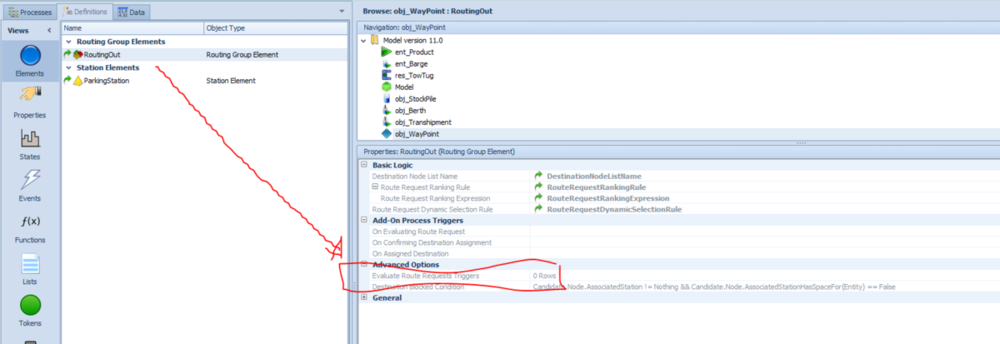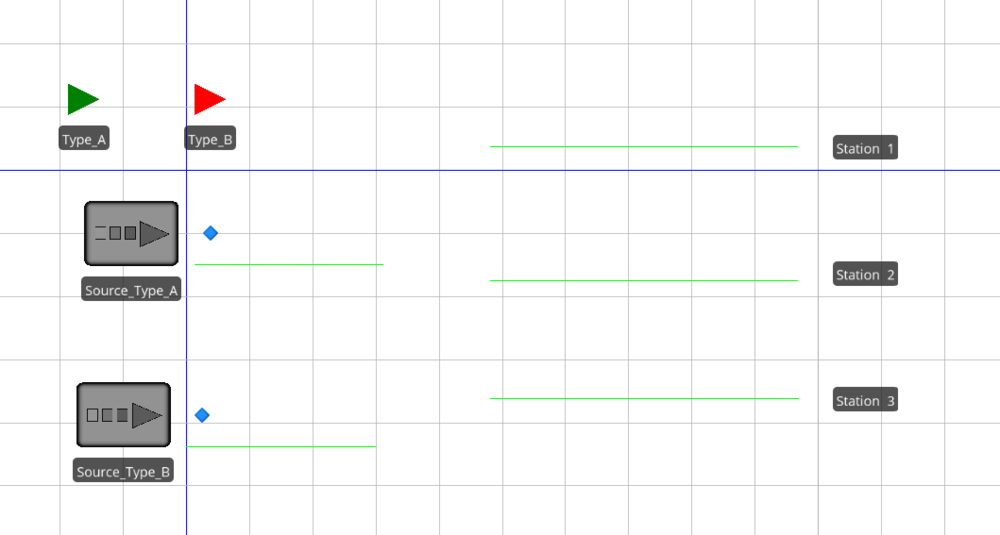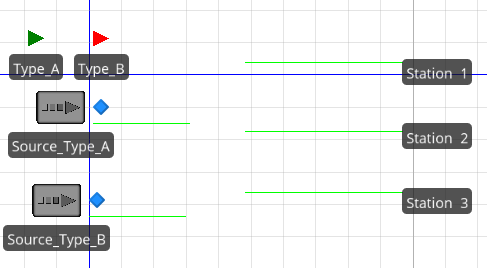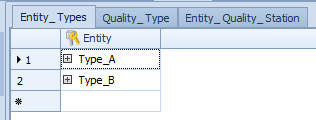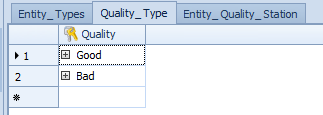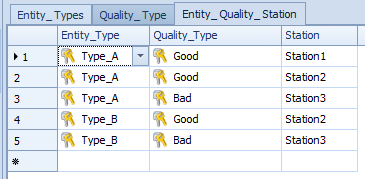Search the Community
Showing results for 'buffer transfer node'.
-
Hi, In the modell I'm working on I have a set of sources that generate different types of entities and two workers that have to grab those entities and trasport then to another node. The decision of which source is unloaded first is defined by a specific probability distribution. However, I don´t know where to define this decision to route the worker. Could someone please help?
-
You need to put the search, release and transfer steps into the Add-on Process Triggers "Parent Entered" of the Combiners. For example, for the "Juntar_secos" combiner, at the "Parent Entered" Addon process, you would search for Slots.Processing.Contents, matching "Candidate.ModelEntity.Id_Del_Pedido == ModelEntity.Id_del_pedido". After that you should use a release step, to release Server "Slots", and a transfer step to transfer what have been found to Output@Slots.
-
Well, first thing, you don't need your entities to be bouncing between the output and the input of your server like that. If you want to use it as sort of storage, set both the processing time and the capacity to infinity. After that, at the moment that the parent entity enters the combiner "Parent Entered" you could search the queue of your storage using a search step with something like "Server1.Processing.Contents", with the condition of "Candidate.ModelEntity.State == ModelEntity.State", release the server and transfer what have been found to the output. You need to take some care on some situations, like what if the parent entity arrives first at the combiner then the member at the storage? And some care with batching quantities aswell. But I think you can handle it.
-
Hello Everyone, please can someone help me with this situation? I want to use a Server as a storage place, entities coming out of it go into the MemberInput of a Combiner. I want the number of entities that leave the Server to depend on the state of the entity that will enter the ParentInput of the Combiner. How can I access the state of the parent entity that will enter the combiner from the Output Node of the Server? Thank you very much, Greetings! 14.10.spfx
-
To model shelves, I am trying to create a series of custom "Shelf" objects (subclass of servers) located in a grid pattern. I used a spreadsheet to automatically calculate the coordinate locations and generate a name (string) for each object based on its position within the grid. With just the Shelf object types in the spreadsheet, can bind the file to my object reference table no problem, import the data, and populate the facility window with my objects. That part works fine! Next, since I have an aisle running between the rows of objects, I wanted to set it up so that the objects all face "inwards", ie. the input and output nodes for the objects are facing the aisle. Originally I thought of rotating the Shelf object, but I ran into 2 issues: first, I discovered that I can't set the Shelf yaw orientation from the table, so that's not going to work. Second, I realized that even when I rotate the Shelf in the facility window, the nodes do not rotate with their parent object. I decided I would leave the Shelf in the same orientation as it is placed, but I would just re-locate the input/output nodes to the opposite edge of the Shelf objects on the far side of the aisle. For this I would need to make sure I can set locations for the input/output nodes in the same object reference table. When I added a row to the object reference table from within Simio (prior to binding to a spreadsheet), a drop down appeared, and I could select the input or output nodes for any object that already existed in the table, and then define the node's location in the cartesian coordinate columns. When creating a node this way, the node location is still relative to the object, ie. I can drag the object in the facility window and the node moves relative to the object, which is perfect. This input/output node creation and relative location definition via table is exactly what I am trying to automate, but this is where I started running into problems. In my spreadsheet I used formulas to generate names for the nodes to match the formatting of the input and output nodes in Simio (ex. "Input@..."/"Output@..."). I also added a formula to assign all input node object types to BasicNodes and all output nodes to TransferNodes and calculate the desired location coordinates for the nodes. The spreadsheet I made has the same format as the table in Simio where I tested manually creating and positioning the nodes. The issue is that when I bind the table and import the spreadsheet data to my model, the node names automatically change and are no longer formatted to reference the parent object. Because of this, these name-changed node objects are created in addition to the input and output nodes that are created for each Shelf object. However, if I remove the binding and add a new row, once again I can find the node name in the drop down list and assign the coordinates manually, and the input/output node that references the parent object will move to where I send it. My question is: how can I set the input/output node locations for the objects when creating objects from a table? There are over 500 Shelf objects in the table so I do not want to locate them manually, but the automated method is not working either. The only idea that I have is to make a new object "Shelf2" and define the external view to have the nodes on the opposite side, but that seems like a less-than-idea solution because then I would have 2 custom objects to update and maintain, that are otherwise identical. I am hoping that I don't have to do this hacky solution but I am interested to see if anyone else has dealt with this and has ideas. Thanks!
-
I wonder if it is possible to pick one particular entity from the BatchMembersQeue and unbatch it. For example I have a pallet with 10 entities batched (9 red and 1 blue) and I want to remove only the blue one. I was able to find the entity with a search step, but I cannot transfer it or unbach it. Any ideas? TnksUnbatch one entity.spfx
-
I need to simulate a crane moving entities between different points. But the problem is the load and unload time are not the same in all those points. I need to be able to define somehow the crane load & unload time as a variable (node depending). I wonder if anyone has dealed with this problem before? Rds.
-
Any chance anyone knows how to access or circumvent the Route Requests Triggers of the default Routing Group within a node ??
-
Hello, I'm modeling an orange factory. One thing that I'm trying to solve is the modeling of the reception pools (of oranges). 1) Arrive trucks. 2) The truck is weight. Every truck have a random value of kilograms of oranges. (integer) 3) The truck dispose the oranges in a workstation. (workstation = reception pool). This is model with a Separator. 3.1) There are 3 workstation. 3.2) Every workstation has diferent Input Buffers. 3.3) The entity once entered in MemberOut@Separator1, it triggers a decide process. 3.3.1) This decide is to choose the workstation depending of the Quantity of Oranges versus the Input Buffer. Now I need to Wait until the Input Buffer is Empty, but I'm having problems with that, because the entities don't release from this server. If there are doubts about the model or anything else, I will answer as fast as possible. test1.spfx
-
Hi All, Used simio a couple of years back and in the process of trying to refresh my skills. I am trying to model a synchronous transfer model in a manufacturing setup. Synchronous meaning - entities will only transfer downstream only after all the entities are processed in their respective servers. Any ideas on which tools to use is highly appreciated. Running a bit tight on time. Thanks all
-
I’m representing an empty container deposit, where the containers are stored in different blocks. Gate in trucks arrives to the deposit loaded with containers that have to be unloaded by cranes and stored in the container blocks. In addition, there are gate out trucks that arrive to the deposit to retrieve containers. In the model, the containers are represented as entities, so as the trucks. I use Stations to represent the blocks that store the containers. To understand the logic of container arrival, we have to notice that next to the Station there is a Transfer Node, and when a container enters the Node (through a Transfer step in a Process), is transferred to the Station. To understand the logic of container retrieval, we have to notice that there is a Combiner next to the Station, and when the truck enters the Parent Input Combiner Node, a Process is triggered that searches for the container in the corresponding Station, and then it to the Member Input Combiner. Given that there is one Station for one block of containers, a single Station is used for the arrival and the retrieval of containers. The problem that I have is that in certain occasions, when a container is going to enter a Station, an error occurs and Simio shows this message: “The entity location is in transition state “WaintingToTransferIntoStation” and a new transfer request is invalid”. I don’t understand why this happens, given that in the Node that triggers the Process that executes the Transfer, only a single container enters at a time. Any help is greatly appreciated! Release: 8.136.13569 Model is attached. https://dl.dropboxusercontent.com/u/41163946/ModelPlacillaNewV3.spfx
-
Hi guys, I am trying to read origins and destinations out of an Excel file. To do this, I defined a process, in which I read the Excel file using "Excel Read", in which I read the origins and destinations and write them in the Node Reference State Variables ExcelOrigin and ExcelDestination respectively. After this, I created an entity, for which I assigned the Node Reference State Variables "ModelEntity.Origin" and "ModelEntity.Destination" to the previously defined "ExcelOrigin" and "ExcelDestination". Then I want to transfer the entity from Free Space to ModelEntity.Origin and set the destination using SetNode to ModelEntity.Destination. However, upon running the model, it states that "The value 'ModelEntity.Origin' for property 'Transfer.NodeName' is a null or undefined reference". It seems that it does not read the nodes properly from the Excel file, but if I change the input in the Excel file to a random number instead of one of the nodes, it presents the error of a data error mismatch; this makes me think that it does read the Excel file and sees whether or not the input are nodes. Is reading Nodes into a Node Reference State Variable from Excel even possible? Anyone who came across the same problem or has a solution? I have included my example in the attachment. Excel Read Node Reference State variable.spfx Input.xlsx
-
I have two models in a project, one which handles supply (results in trucks being routed to one of several sinks) and one which handles demand (various sources). I would like to connect the sink of my supply model to the source of the demand model. Can I transfer entities between models? Or do I need to manually copy and paste each object from one of my models into the other to allow for the transfer of entities? This may be very simple, sorry if I'm the annoying newbie! Joy
-
Hi, I have a bottleneck at the end of my assembly line. I cannot dupplicate that station as my total number of workers is already high. Before hiring, I would like to try and reallocate and have satellite employees. I want to allocate my workers to that station when the input buffer has exceeded one entity. Every worker has to finish the entity they are presently working on at the other stations and the first workers that are done need to go the bottleneck station. The rest of the time, the workers can be allocated based on the smallest distance to the work stations. The bottleneck station usually requests 4 workers. That information is already set up in a table. When there is two entities in queue in that buffer, I want workers to be able to go finish the work and hence increase the processing time by X. I have tried a lot of different things, and all my data is stored in relational tables. Thanks!
-
That is what I thought. However, my results are not making any sense. I see the following: Logically, adding 5 hours of travel time via an interdiction should lower the responses (at the very least the FuelTotal) however, this is not the case. Just as a quick test I changed the interdictions to negatives and received more logical results. However, when I view individual runs of each of these cases, the opposite of these results is what I receive: Fuel levels plummet and reach 0 multiple times during the scenario since the transports can't keep up (w/ 5hr interdiction) or the transports 'teleport' to the ACo node since there is a -5hr interdiction and therefore the transports are always able to keep the servers at high fuel levels. I must be missing something here.
-
Conditional entity release one at a time
gocken replied to Amine3225's topic in SI General Discussions
Hi Amine, I have defined a new process named process1 which is triggered by Input@BUFFER_ST_1.Entered event. Then, I used interrupt step (in process 1) to get one entity from processing station whenever process 1 is triggered. Note that I set the processing time of BUFFER_ST_2 server to infinity to hold entitys until Input@BUFFER_ST_1.Entered event is occured. I am not sure if setting this to infinity is a problem?. Other than this everything is ok and it seems it works. Buffer varianti trazioni V2.spfx -
Hello, I'm new to both the forum and the world of simio in general. I am trying to simulate how much the maximum buffer could be in 2 points of my process which are defined by the Buffer_ST1 and Buffer_ST2 servers. My problem is that I would like the Buffer_ST2 server based on a condition that would be every time an entity passes on Input @ Buffer_ST1, the Buffer_ST2 server releases only one processed entity and not all those inside the server as it happens now, I hope for being clear and thank you in advance. I put the model in the attachment Buffer varianti trazioni V2.spfx
-
In the attached model, I want to transfer entities to stations depending on some criteria defined in a table. I have 2 types of entities, "A" and "B", defined in a table as primary keys. Also I have 2 states, "Good" or "Bad", also in a table as primary key. Finally I have 3 stations. I have a table that has 3 columns, “Entity_Type”, “Quality_Type” and “Station”. For example a row could be "A"; "Good"; "Station 1". It is possible for entity "A" with "Good" quality to end up in either "Station 1" or "Station 2", and in that case I want to randomly select one. The problem is that I cannot use a RandomRow based in more than one criteria. Either I use RandomRow for the rows of the table that are type "A" or quality "Good", but I am not finding a way to do more than one combination. This model is a simplification of the real model which is more complex and has hundreds of combinations. Model_RandomRow_FilteredTable.spfx
-
Hello Simio Forum. I’m just starting a model which, for me, is a little unique as I have only used servers in a task capacity through steps. The new liquid ink model consists of 4 lines with each line made up of 3 steps each having a volume of 3.5 tonnes. 1. PreMix 2. Mill with a recirc tank 3. PostBlend I do not seem to be able to model this using servers because I cannot represent the transfer time of product occupancy between steps. I need this to show utilisation/uptime of the steps. But when I look at using "Flow" tanks I cant add the process tasks the same as servers (rows) i.e. gather weigh, milling time, QC etc.. Plus will need to add/link worker steps. Is there a middle ground between servers & tanks? Thanks Martin
-
I'm making a simple simulation model of a hospital and I'm having trouble with the routing of my model. For instance, a patient first goes through ED and then to OR. if there is no room in the OR, then the patient must stay in ED. How can I model this? I don't want the patient to wait at any input or output buffer, because then it assumes that the ED bed that the patient used to stay in is now free but it actually isn't. Each bed is modeled as a server and there are more ED beds than there are OR beds. Naturally, all ED beds connect to a single transfer node, which then connect to all OR beds.
-
Hello All, I'm trying to create a model that will keep track of processing time for each transaction processed and reroute transactions that exceed a processing time threshold to an alternate sink. Initially, I attempted to rework the "Remove from Allocation Queue" Simbit, but the "Remove" process only seems to work with queues. The model itself is very simple. Single source with a random exponential inter-arrival time, single processor with capacity of 50 and 2 sinks; one for completed transactions and one for long running transactions which are manually routed. Any guidance you can provide would be greatly appreciated. Thank you, Ryan
-
I'm addressing a Multi Product Multi Routing situation. What's the best way to model a buffer without using the Server or WorkStation blocks? N machines are connected to M machines producing different products with alternative routing. Therefore, having a common buffer where entities coming from different machines could wait for the first available machine in any alternative route is very important. My question is whether this would perform better with stations or storages (or any other object in Simio). I intend to experiment on Buffer size to optimize space requirements. This would be done using experiments hence the chosen object/method needs to be suitable for that. Scheme: [n1] ___________ [m1] [n2] | | [m2] [n3] | Buffer | . . |___________| . . [M ] [N ] Thank you in advance
-
We are building a model of a medical facility where some patients need to be evacuated out of the model using a vehicle. In its current state, when a patient is in the ward or ICU, it will be determined if they need to evacuate. While they are waiting for an evacuation transport, they will be in a task sequence loop. We would like some way for the patient to seize a spot on the transport, perform the tasks loops, and once the transport arrives at the facility transfer node, the patients break out of their loop, and seize a worker to be carried to the vehicle. We have patients looping correctly and workers carrying the patients to the transport node, but they are not waiting for the vehicle to arrive. Having a condition that breaks the loop when the vehicle is in the loading node is not working because as it leaves its current node does not update quickly enough so entities go to the node that then are not picked up. A potential solution we found was to use the MinimumDwellTimeExpired State variable for the Evac transport in the loop conditional (If transport is dwelling then do not continue the loop and get routed to the transport, if it is not dwelling stay in the loop), however this variable is not public with no apparent way to make it so. We have also tried to make a function in the vehicle to try and mirror the state variable value, but this also did not seem to work as it does not update during the run.
-
AssociatedStationOverload is always -infinity
jsmith replied to Sreenath Chalil Madathil's topic in SI General Discussions
Yes, the buffer is set to 0 in the model distributed with the book. The book verbiage mentions that using Infinity for buffers will cause a tie in the selection logic, but we need to add some additional discussion about the differences between using values of 0, 1, 2, etc. for the buffer capacities. -
I am recreating the model 5.3 of the Simio and Simulation textbook. When I create the list and run the model, with selection expression in the output@placement node as below candidate.Node.AssociatedStationOverLoad, all entities goes only to finepinchfaststation. However, when I use Candidate.Node.AssociatedStationLoad it selects all desitnation loads. Is there any change to the Candidate.Node.AssociatedStationOverLoad? I displayed the values in the facility window and it is coming as -infinity. Model_05_02.spfx




